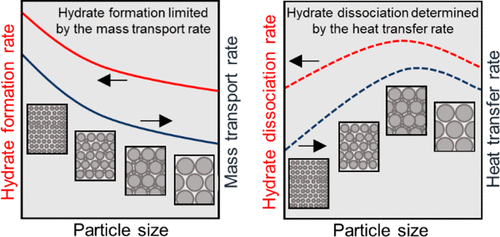当前位置:
X-MOL 学术
›
Energy Fuels
›
论文详情
Our official English website, www.x-mol.net, welcomes your
feedback! (Note: you will need to create a separate account there.)
Influence of Particle Size on the Heat and Mass Transfer Characteristics of Methane Hydrate Formation and Decomposition in Porous Media
Energy & Fuels ( IF 5.2 ) Pub Date : 2021-01-21 , DOI: 10.1021/acs.energyfuels.0c03812 Xiao-Yan Li 1, 2, 3, 4, 5 , Xiao-Sen Li 1, 2, 3, 4 , Yi Wang 1, 2, 3, 4 , Gang Li 1, 2, 3, 4 , Yu Zhang 1, 2, 3, 4 , Heng-Qi Hu 1, 2, 3, 4, 6 , Kun Wan 1, 2, 3, 4, 5 , Hao-Peng Zeng 1, 2, 3, 4, 5
Energy & Fuels ( IF 5.2 ) Pub Date : 2021-01-21 , DOI: 10.1021/acs.energyfuels.0c03812 Xiao-Yan Li 1, 2, 3, 4, 5 , Xiao-Sen Li 1, 2, 3, 4 , Yi Wang 1, 2, 3, 4 , Gang Li 1, 2, 3, 4 , Yu Zhang 1, 2, 3, 4 , Heng-Qi Hu 1, 2, 3, 4, 6 , Kun Wan 1, 2, 3, 4, 5 , Hao-Peng Zeng 1, 2, 3, 4, 5
Affiliation

|
In nature, permafrost regions and deep ocean sediments contain a large amount of gas hydrate. As a basic property of the sediments, the particle size of the porous media is a critical factor affecting hydrate production. In this study, methane hydrate formed and dissociated in the sediments with different particle sizes, including the particle sizes of 14–20 mesh, 35–60 mesh, 80–120 mesh, and 400–500 mesh. The experimental results showed that two stages were included during the hydrate formation process. In the first stage, the hydrate was mainly formed in the upper of the sediments, which hindered the further contact of gas/water and resulted in the decrease of the hydrate formation rate in the second stage. As the particle size of the porous media decreased, the induction time for the hydrate nucleation decreased and the hydrate formation rate increased. In the porous media with 400–500 mesh, the hydrate started forming while the gas was injected into the hydrate simulator. It was found that the hydrate formation rate in the sediments was limited by the mass transport rate of gas and water. In the constant pressure stage (CPS) of the hydrate dissociation, the maximum value of the hydrate dissociation rate was obtained in the porous media with 35–60 mesh. It was found for the first time that the change characteristics of the average hydrate dissociation rate with the medium particle size of the porous media were similar to those of the effective thermal conductivity with the medium particle size of the porous media. This demonstrated that the heat transfer rate of the sediments determined the hydrate dissociation rate, and the influences of the capillary force and the hydrate distribution on the hydrate dissociation were minor. The experimental results also suggested that the coarse-dominated sediments are more advantageous for gas hydrate production.
中文翻译:

粒径对多孔介质中甲烷水合物形成和分解的传热传质特性的影响
在自然界中,多年冻土区和深海沉积物含有大量的天然气水合物。作为沉积物的基本特性,多孔介质的粒径是影响水合物生产的关键因素。在这项研究中,甲烷水合物在具有不同粒径的沉积物中形成和分解,包括14-20目,35-60目,80-120目和400-500目。实验结果表明,水合物形成过程包括两个阶段。在第一阶段中,水合物主要形成在沉积物的上部,这阻碍了气/水的进一步接触,并导致第二阶段中水合物的生成速率降低。随着多孔介质粒径的减小,水合物成核的诱导时间减少,水合物形成速率增加。在400-500目的多孔介质中,当将气体注入水合物模拟器时,水合物开始形成。发现沉积物中水合物的形成速率受到气体和水的质量传输速率的限制。在水合物分解的恒压阶段(CPS),在35-60目的多孔介质中获得了水合物分解速率的最大值。首次发现,平均水合物解离速率随多孔介质的中等粒径的变化特征类似于有效导热率随多孔介质的中等粒径的变化特征。这表明,沉积物的传热速率决定了水合物的解离速率,而毛细管力和水合物的分布对水合物的解离的影响很小。实验结果还表明,以粗粒为主的沉积物更有利于天然气水合物的生产。
更新日期:2021-02-04
中文翻译:

粒径对多孔介质中甲烷水合物形成和分解的传热传质特性的影响
在自然界中,多年冻土区和深海沉积物含有大量的天然气水合物。作为沉积物的基本特性,多孔介质的粒径是影响水合物生产的关键因素。在这项研究中,甲烷水合物在具有不同粒径的沉积物中形成和分解,包括14-20目,35-60目,80-120目和400-500目。实验结果表明,水合物形成过程包括两个阶段。在第一阶段中,水合物主要形成在沉积物的上部,这阻碍了气/水的进一步接触,并导致第二阶段中水合物的生成速率降低。随着多孔介质粒径的减小,水合物成核的诱导时间减少,水合物形成速率增加。在400-500目的多孔介质中,当将气体注入水合物模拟器时,水合物开始形成。发现沉积物中水合物的形成速率受到气体和水的质量传输速率的限制。在水合物分解的恒压阶段(CPS),在35-60目的多孔介质中获得了水合物分解速率的最大值。首次发现,平均水合物解离速率随多孔介质的中等粒径的变化特征类似于有效导热率随多孔介质的中等粒径的变化特征。这表明,沉积物的传热速率决定了水合物的解离速率,而毛细管力和水合物的分布对水合物的解离的影响很小。实验结果还表明,以粗粒为主的沉积物更有利于天然气水合物的生产。











































 京公网安备 11010802027423号
京公网安备 11010802027423号